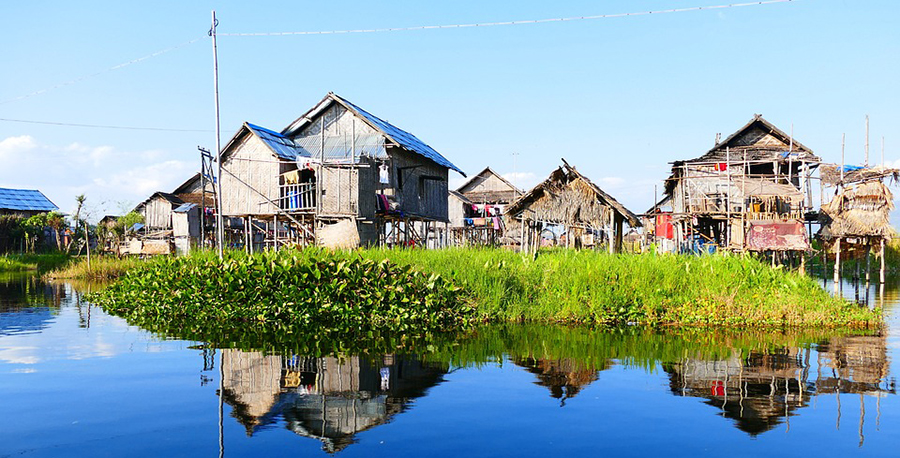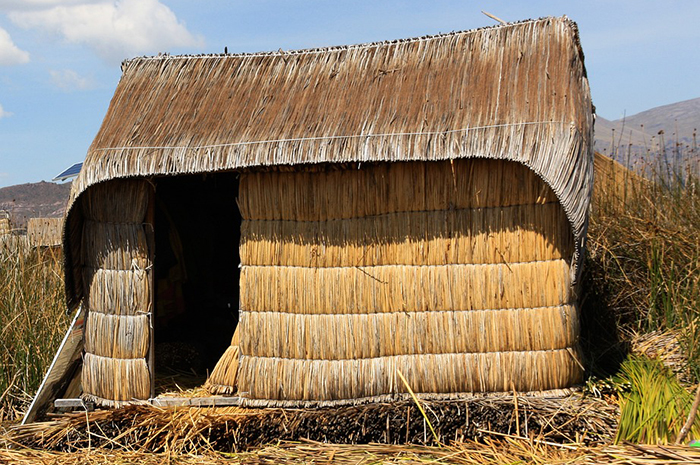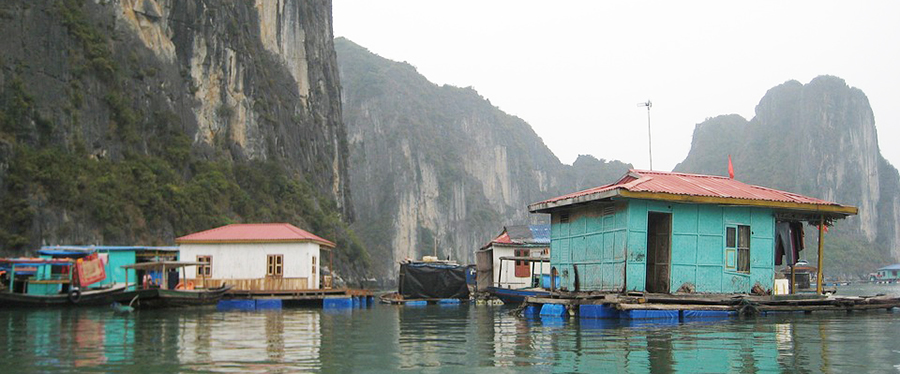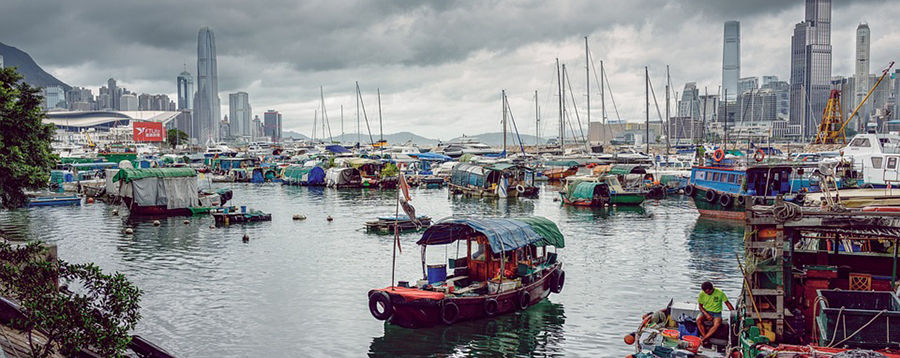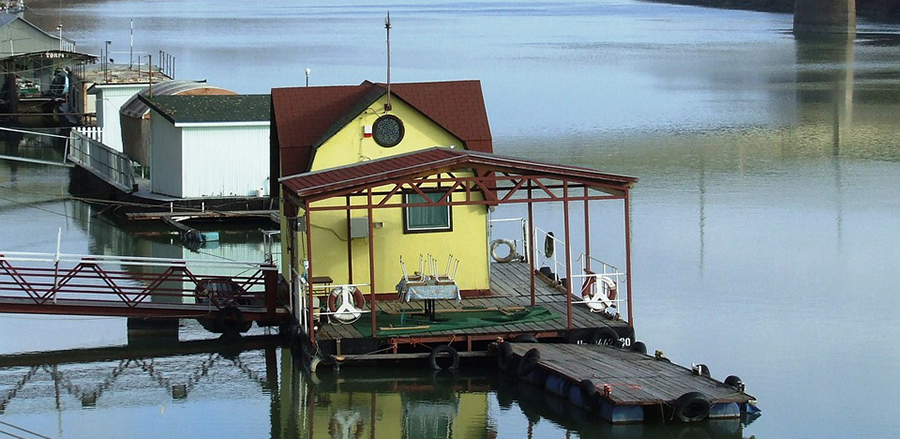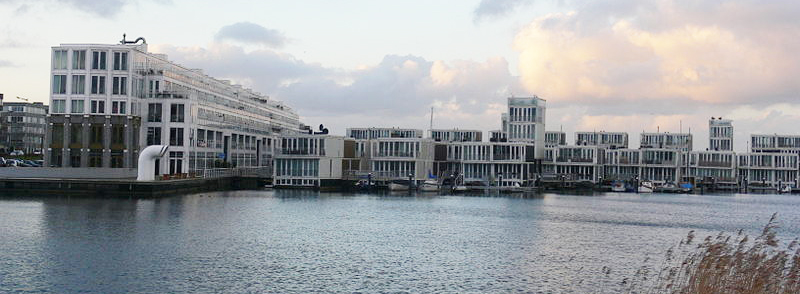Water-based communities
Contents |
[edit] Introduction
Water based communities have existed for many years, with characteristics and typology of settling on major rivers, water regions or canals with a close relationship to water. The typology varies to some extent based on how the dwellings exist on the water, by either floating directly or being raised above the surface supported by stilts or in some cases a combination of both. Floating structures are designed to float on water, such as a pontoon, as opposed to a pier which is raised on legs dropped into the bed beneath the water.
The interest in floating developments has increased in recent years partly due to improvements in design and technology, but also because of the increasing need for communities to protect themselves from flooding. The US Centre for Climate Integrity estimates that by 2040 the US economy will have invested 400 billion dollars protecting coastal cities and the same would apply globally. As a result many contemporary cities and developments are looking at flooding issues, and many are actively investigating solutions. A few examples are given below:
- Shanghai's 520 km shore line flood protection wall.
- Hafen city flood proof neighbourhood, Hamburg Germany, has been designed raised up allowing ground and water level spaces to flood with a gate system to protect certain areas from further flooding.
- Hammarby lake city with urban landscape designed to accommodate storm waters.
- The dryland project to protect Manhattan from flooding through landscape design and protection.
Whilst designers have always developed conceptual ideas for living on water, and many smaller examples of contemporary water living exist, more formal investigations as a result of urban population growth and the need for future proofing have given these solutions more weight. Such ideas have developed into a derivation of the term 'seastead' to describe potential floating cities, for example in cities such as New Orleans, parts of which lie below sea level or Lagos in Africa. There are many examples but in particular Oceanix City, designed by the firm BIG, which is a UN supported concept for a floating city and Blue21, a Dutch tech company focused on floating buildings, working on a scheme for the Baltic Sea connected to a privately funded underwater rail tunnel to link Helsinki, Finland and Tallin in Estonia.
Below is a brief look at some communities that have been living in this way close to the water, from specific historical vernacular floating and stilted examples to more common boat dwelling communities.
[edit] Vernacular floating communities
Whilst many examples exist of communities living on raised platform dwellings or seasonal dwellings, there are relatively few example of long standing vernacular communities that have lived afloat in permanent dwellings. Some of these are given here:
[edit] Mogen, Thailand
Mogen, Thailand is a nomadic floating community, whose origin is either Indian or Indonesian, they inhabit waters off Burma, Thailand, Malaysia, and Borneo, spending their lives on boats, with unique customs, traditions and language.
[edit] The Uros, Peru
The Uros people live on floating (Totora) reed islands, in houses also constructed of reeds and are said to have originated from before the Incas. They survive by fishing and from tourism.
[edit] Ha-Long (bay), Vietnam
Ha-Long (bay), Vietnam, initially for returning fishermen selling their catch, there aer now floating settlements of around 1,600 in four villages (Cua Van, Ba Hang, Cong Tau and Vong Vieng) in the UNESCO World Heritage designated bay.
[edit] Aberdeen, Hong Kong
A floating village established by a group known as Tanka, who settled in around 700 as the harbour grew. The area has about 600 junks (the local term for specific types of boats) and is home to 6,000 people.
[edit] Other floating communities
The Netherlands is a region that has historically one of the closest relationships to water, flooding and floodplains. Rotterdam itself is 90% below sea level and has the world's largest floating office building, a floating farm and a floating pavilion, meeting and event space.
Other examples of individual floating developments also exist in Copenhagen in Denmark and there are larger developments of informal communities in many major cities such as London, Berlin and Paris.
More formal contemporary developments are not commonplace, but below three completed examples:
[edit] Schoonschip, Netherlands
Schoonschip is a modern development of 46 homes for 100 people located in Amsterdam. It was completed in 2021. For further information visit https://schoonschipamsterdam.org/en/
[edit] Brighton Marina, UK
Brighton Marina in the 1980's in the UK was part of a marina development. Two floating plinths house seventy split level studio holiday homes that were the UK's first floating home development. There was also a plan for a floating development in the Royal Docks in London, though this has been delayed.
[edit] Amsterdam IJburg, Netherlands
Made up of four man-made islands, 6 km from the city of Amsterdam a number of developments offering housing for 45,000 people with a total of 18,000 apartments include the floating house developments of Waterbuurt-Oost and Waterbuurt-West (image credit Remi Mathis Creative Commons Attribution-Share Alike 3.0)
.
[edit] Vernacular stilted communities
Homes on stilts are a more common vernacular of water-based communities, sometimes the stilted houses depend of tide levels.
[edit] Ko Panyi, Thailand
Ko Panyi, Thailand is a fishing and now tourist village built on stilts in the Phang Nga Province below the shadow of a vertical limestone cliff, with a population of about 1,700. It includes a school, market, mosque, and even a football pitch.
[edit] Bajau, Borneo
Having relocated from the Sulu Archipelago in the Philippines to Sabah and Borneo, the Sea Gypsies live on boats and stilt houses and until relatively recently were disconnected from the outside world,
[edit] Yawnghwe, Mayanmar
A population of 70,000 in 17 settlements live on the lake of Inle. The houses are built on stilts whilst goods and people move with kayaks. Fishing is the main activity as well as tourism.
[edit] Ganvie, Benin, Africa
This stilt village on Lake Nokoué, is the settlement of people of Tofinu ethnicity, built in the 16th century, to escape the Fon warriors, now with a population of almost 20,000 people, with a school, hospital, floating shops and even a hotel targeting tourists. The mode of transportation is kayak while the main occupation is fishing and trading fruits and vegetables. Known as the Venice of Africa, Ganvie is now Africa’s largest lake village.
[edit] Kampong Khleang, Cambodia
Southeast of Siem Reap, these stilt buildings house around 6,000 people who live by fishing and shrimping, when the water level is high. When water is lower with exposed stilts they relocate to the mainland.
[edit] Tonle Sap, Cambodia
The largest floodplain in the world and freshwater lake in Asia, listed as a UNESCO Biosphere in 1997 which has almost 170 floating villages supported by stilts across the lake.
[edit] Day-asan, Philippines
This floating fishing village in Surigao City, is housed on wooden stilt structures with around 2,000 people. It has individual dwellings, community buildings and pedestrian bridges and is called the Venice of the region.
[edit] Other stilted communities
Buildings constructed using stilts are actually quite common place as they are the equivalent of piles, which are used for construction on ground that is unstable, there are a number of examples of such construction however one of particular note is given below.
[edit] Venice, Italy
One of the most famous water based communities which is not considered stilted is Venice, Italy. Venice’s buildings were built on 10 million tree trunks, driven down into the solid sedimentary clay of a marshland called Caranto. On top of these are two layers of heavy wooden planks, then a layer of stone blocks. On top of this the city’s foundation walls were built, these can be seen above the waterline today.
[edit] Pfahlbaumuseum Unteruhldingen, Germany
Finally although not a community per se this archaeological open-air stilt house museum on Lake Constance (Bodensee) in Unteruhldingen consists of a number reconstructed stilt houses and dwellings from the Neolithic and Bronze Age.For more information visit: https://www.pfahlbauten.de
--Editor
[edit] Related articles on Designing Buildings
Featured articles and news
RTPI leader to become new CIOB Chief Executive Officer
Dr Victoria Hills MRTPI, FICE to take over after Caroline Gumble’s departure.
Social and affordable housing, a long term plan for delivery
The “Delivering a Decade of Renewal for Social and Affordable Housing” strategy sets out future path.
A change to adoptive architecture
Effects of global weather warming on architectural detailing, material choice and human interaction.
The proposed publicly owned and backed subsidiary of Homes England, to facilitate new homes.
How big is the problem and what can we do to mitigate the effects?
Overheating guidance and tools for building designers
A number of cool guides to help with the heat.
The UK's Modern Industrial Strategy: A 10 year plan
Previous consultation criticism, current key elements and general support with some persisting reservations.
Building Safety Regulator reforms
New roles, new staff and a new fast track service pave the way for a single construction regulator.
Architectural Technologist CPDs and Communications
CIAT CPD… and how you can do it!
Cooling centres and cool spaces
Managing extreme heat in cities by directing the public to places for heat stress relief and water sources.
Winter gardens: A brief history and warm variations
Extending the season with glass in different forms and terms.
Restoring Great Yarmouth's Winter Gardens
Transforming one of the least sustainable constructions imaginable.
Construction Skills Mission Board launch sector drive
Newly formed government and industry collaboration set strategy for recruiting an additional 100,000 construction workers a year.
New Architects Code comes into effect in September 2025
ARB Architects Code of Conduct and Practice available with ongoing consultation regarding guidance.
Welsh Skills Body (Medr) launches ambitious plan
The new skills body brings together funding and regulation of tertiary education and research for the devolved nation.
Paul Gandy FCIOB announced as next CIOB President
Former Tilbury Douglas CEO takes helm.
UK Infrastructure: A 10 Year Strategy. In brief with reactions
With the National Infrastructure and Service Transformation Authority (NISTA).







